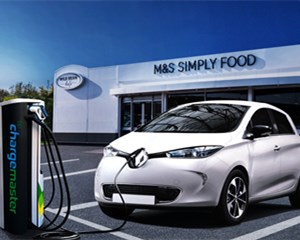Capacitors, by contrast—whether basic or "super"—consist of a pair of electrically conductive plates placed either side of a separator material. When a voltage is applied to these plates, a positive charge builds up on the surface of one and a corresponding negative charge on the other. Connect the plates through an external circuit and, as with a battery, a current will then flow.
相比之下,無論是堿性電容器還是超級電容器,都是由一對導電板組成,它們分別位于隔膜材料的兩側。當導電板被施加電壓時,其中一塊導電板的表面產生正電荷,另一塊導電板的表面則產生相應的負電荷。之后通過外部電路將兩塊導電板進行連接,就像電池一樣,電流就會開始流動。
Making the leap from a basic capacitor to the super variety involves two things. One is to coat the plates with a porous material such as activated carbon, to increase the surface area available for energy storage. The other is to soak them in an electrolyte. This creates yet more storage area in the form of the electrolyte's boundary with the plates. But adding an electrolyte to the mix also brings the possibility of adding a bit of battery-like electrochemistry at the same time. And Skeleton Technologies, an Estonian supercapacitor firm, plans to do just that.
從基礎電容器到超級電容器的飛躍涉及兩點。一點是要在導電板上涂上如活性炭等的多孔材料以增加存儲能量的可用表面積,另一點是要將它們浸泡在電解質中,這樣就能在電解質與極板的邊界處形成更多的存儲區域。不過,在混合物中加入電解質的同時可能也會加入一些類似電池的電化學元素。愛沙尼亞的一家超級電容器公司“骨架技術”正計劃這樣做。

Plate tectonics
導電板構造
Skeleton has already developed plates composed of what it calls "curved" graphene, for a new range of straightforward supercapacitors. Ordinary graphene is a single layer of carbon atoms arranged in a hexagonal grid. It is highly conductive. Skeleton's curved variety consists of crumpled sheets of the stuff. The consequent increase in surface area will, the firm hopes, push the energy density of its new products to 10-15wh/kg—a good fraction of the theoretical maximum for a supercapacitor of 20-30wh/kg.
骨架公司已經開發出一種由所謂的“彎曲”石墨烯組成的導電板,用于一系列新的簡單的超級電容器。普通石墨烯是一層排列成六邊形網格的碳原子,導電性很強,而骨架公司的“彎曲”石墨烯則是由褶皺的材料組成的。該公司希望由此增加的表面積能將其新產品的能量密度提高到10-15wh/kg——即一個20-30wh/kg的超級電容器理論上能夠達到的最大值的一個不錯的節點。
That, though, is just the start of Skeleton's plan. The firm's engineers are now working with the Karlsruhe Institute of Technology, in Germany, to use curved graphene in what it calls its "SuperBattery". Though this remains basically a supercapacitor, storing most of its charge electrostatically, the electrolyte will, says Sebastian Pohlmann, Skeleton's head of innovation, also provide some chemicalenergy storage. The company is keeping mum about the electrolyte it uses and the chemistry involved. "It is not comparable to the classic lithium-ion chemistry," is all that Dr Pohlmann will say. But the overall consequence, he claims, will be something that is rechargeable within 15 seconds and has the ability to store 60wh/kg. Skeleton aims to start producing this commercially by 2023.
而這只是骨架公司計劃的開胃小菜。該公司的工程師正在和德國卡爾斯魯厄理工學院合作,將彎曲石墨烯用于所謂的“超級電池”當中。骨架的創新負責人塞巴斯蒂安·波爾曼說,雖然它本質上還是一個超級電容器,以靜電方式儲存大部分電荷,但電解質也能提供一些化學能量儲存。然而,該公司對其使用的電解質和所涉及的化學成分閉口不提。波爾曼博士只是說:“傳統的鋰離子化學無法和它相提并論。”他聲稱,最后的成果就是,該電池可以在15秒內充滿電并儲存60wh/kg的能量。骨架公司計劃于2023年前對該超級電池進行商業化生產。
Other groups, too, are working on ways to add chemical-energy storage to a supercapacitor. Researchers at Graz University of Technology in Austria, for example, have developed a version that has its electrical contacts coated with carbon which is pierced by tiny pores. One contact operates like a capacitor plate, the other like a battery electrode. Unlike Skeleton, the Graz group are open about their approach to electrolyte chemistry. They are using aqueous sodium iodide (ie, a solution of sodium ions and iodine ions). At the electrode, the iodide turn into elemental iodine, which crystallises within the pores during discharge. This process then reverses itself when the device is charging. The pores in the plate serve to accommodate sodium ions similarly.
其他研究小組也在研究如何為超級電容器增加化學能量存儲。例如,奧地利格拉茨科技大學的研究人員已經開發出了一種電觸點上涂著能被小孔穿透的碳的電池。其中一個電觸點相當于一個電容板,另一個電觸點相當于電池的電極。和骨架公司不同的是,格拉茨小組對電解液化學的研究方法持開放態度。他們使用的是碘化鈉水溶液(即鈉離子和碘離子的溶液)。碘離子在電極上轉化為碘元素,在放電過程中在小孔中結晶。當設備進行充電時,這一過程會反過來進行。電容板上的孔也同樣用于容納鈉離子。
譯文由可可原創,僅供學習交流使用,未經許可請勿轉載。











